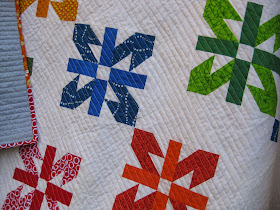We don't have a chandelier, but I have now finished my quilt from the Chandelier Quilt-along which Lee of Freshly Pieced ran on the Bernina We all Sew blog (here). I blogged about this here and ground to a halt while waiting for more background fabric, then Christmas etc happened.

So, encouraged by finishing my Scrappy Trip last week, I plunged on and finished the piecing AND quilting at a run: simple straight line quilting with the walking foot, lines about 1/2" apart.
I like the ribbed texture.
These are my tips if you are tackling a biggish project with straight lines if, like me, you don't have a guide to attach to your machine foot to keep the spacing accurate.
- Mark lines parallel to the vertical seams. I used a Hera marker which shows up fine on light coloured fabric - you may need to experiment of you have darker or busier fabric.
- Don't mark every line. I chose to mark lines 1" apart. I quilted these and then went back and added the lines in between by eye. They are not absolutely straight but I am a person, not a robot, and I think it adds interest to have a bit of wobble here and there.
- Most important tip is to start all of the quilting lines at the top of the piece - do not reverse the direction of travel. If you do you will get puckers as the fabric is pushed first one way and then the other. I start in the middle of the quilt's top edge and then work out towards the right hand side ie the amount of fabric under the machine arm will reduce with each quilting row. Then I'm afraid you will have more of a battle as you work from the middle out towards the left hand side of the quilt, so there will be more fabric scrunched under the arm with each row quilted.
This quilt is a smidge under 60" square and it is do-able; I'm not sure about rib-quilting a really massive quilt, I'll let you know when I've done one. Just resist the temptation to turn and work up from the bottom if you possibly can, it's worth it.
The soft grey speckle fabric on the back was a curtain remnant (Stippleglaze from Osborne & Little) which I must have picked up somewhere, but it is very lightweight cotton so fine for quilting. Scrappy binding to pull all the colours together.
So what did I start? In the course of my spring clean I pulled out some charm squares bought on impulse at a show a couple of years ago - Wildflower by Kathy Davis for Free Spirit the selvage says - and just waiting for the right pattern to inspire me.
I thought about the Broken Dishes block in a star setting which I have seen on Pinterest and loved, but the 5" squares made an 8 1/2" block which would make a 16 1/2" star block - a bit clunky I felt.
What to do? Ran through various possibilities in my head, nothing clicked. Then I remembered the Missouri Star Quilt Company had a Disappearing Hourglass tutorial. Now I don't call this block the Hourglass block; to me the Hourglass is a square quartered diagonally, ie the centre portion only of the block shown above, but leaving the name aside, we were talking about the same block.
And this is the result. Aren't they adorable little blocks - mine are smaller than the MSQC ones, being made from 5" squares rather than a 10" Layer Cake: mine finish at 7". I am thrilled - I think the fabrics work well and are fresh against the white tone-on-tone (it has a swirly vine which you probably cannot see - barely there but not an actual solid, also from stash).
Couple of comments on the tutorial, which is lovely and full of Jenny Doan's usual enthusiasm. I have a personal issue with the method Jenny uses to make her HST's: I think it is not helpful to have all those bias edges on the outside of the HST's as the stretchiness may distort the block.
I made my HST's by the time-honoured method of drawing a diagonal line corner to corner and stitching 1/4" either side, then cutting and trimming to 4 1/2" with my Bloc_loc square ruler.
I would also recommend pressing some of the main seams open to help flatten the block; this really helps when you come to cut up the Hourglass block as the ruler is less likely to slip. Best Press is my best friend here.

They will look even better when they are joined up - next week, I hope. Tune in then!





No comments:
Post a Comment